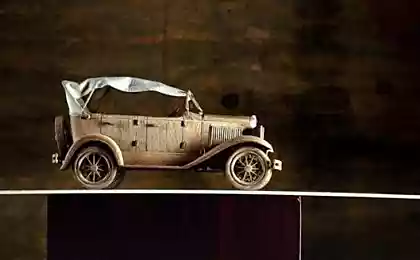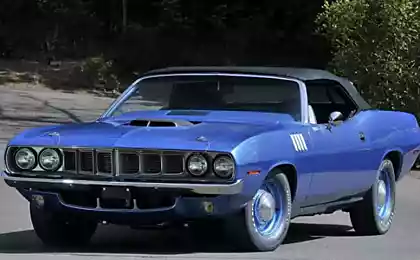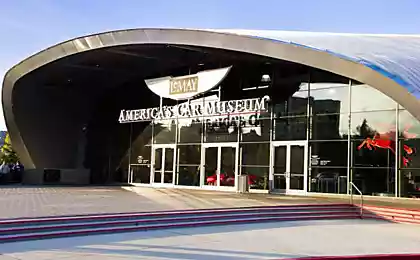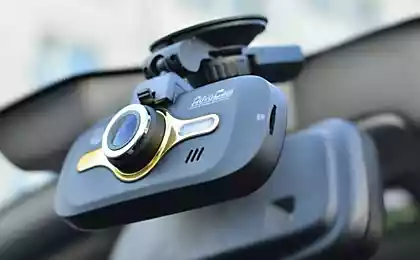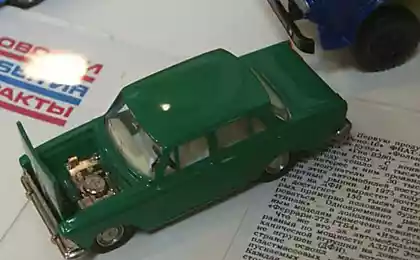1044
Ford Model T
48 photo, 2 video. Please do not break. via Samsebeskazal
Yesterday's shooting day of the series Boardwalk Empire took place in the street, and were involved in the scene old cars. Today, not a word about the movie, but only about cars. Especially because I have long ago did not write about them.
1.

All the cars were the same model - it was the legendary Ford T in different versions. On the Internet, he found the name "Tin Lizzie", which is a direct translation of the American nickname «Tin Lizzy», which in my opinion is not very true, if you try to understand its origins. There are several versions of the origin of the name, and none of them confirmed. I was the closest one in which they say that Lizzie was the most common nickname workers horses on change which came inexpensive and reliable Ford-T. He was immediately christened the same name as that of a horse. Tin - Tin-plated iron is - tin, used to make cans. It would be correct to say "Tin Lizzie." Ford Model T cars were produced so much, and they were so long that later became known as the Tin Lizzy any old collapsing technique. We now call the old car-wreck "bucket", as the Americans called tin lizzy.
2.
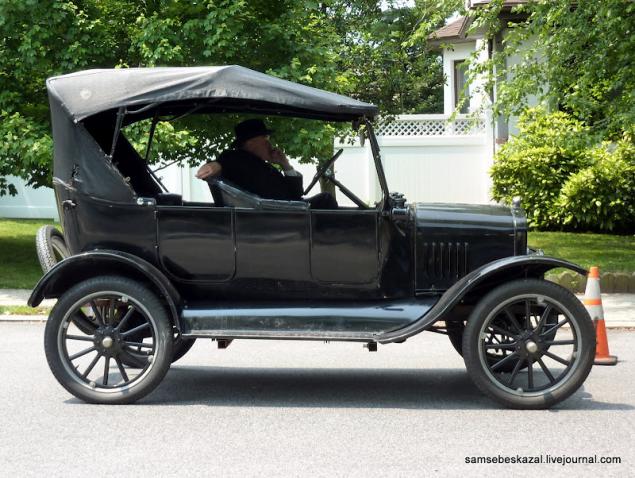
Henry Ford himself called his Ford T "the universal car," the owners, in addition to Tin Lizzie nazyvalie simply Tee, rattletrap, clunker, wreck, bug-infested on gasoline go and many other equally colorful nicknames. But it's certainly love. Indeed, precisely because America Lizzie sat behind the wheel of the car and went.
3.

4. "The car can be any color, provided that the black" - once said Henry Ford. The reason was the assembly-line production and the fact that of all the enamels used for painting, most likely it dries black. For only 48 hours, while other colors could dry weeks. With the development of chemistry, this problem has disappeared, and Ford began to offer the body in other colors, but the wings and some elements still remained black due to the nature of the conveyor assembly.
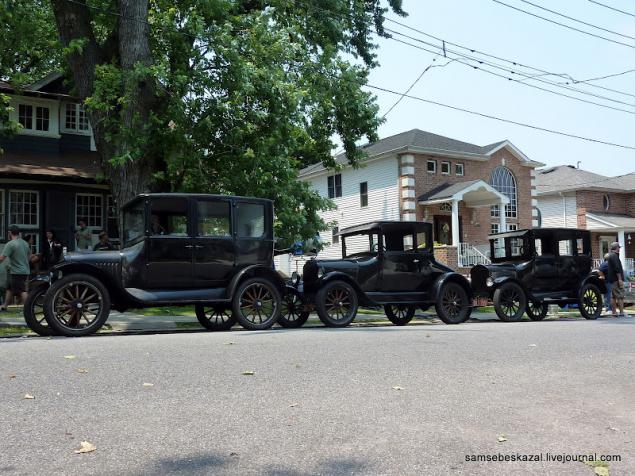
5. The suspension consisted of two transverse springs. Because of this, the car pretty well swayed from side to side over the potholes and bumps. A road was then America consisted entirely of the most bumps and irregularities. Highway in the United States was not there, but the bad roads was rife. Due to the large ground clearance is perfectly overcome any off-road, and if they get stuck, then pull the car weighs just 850 kilograms on narrow tires are not a serious problem. Several adult men could easily pushed him even from the deepest mud.
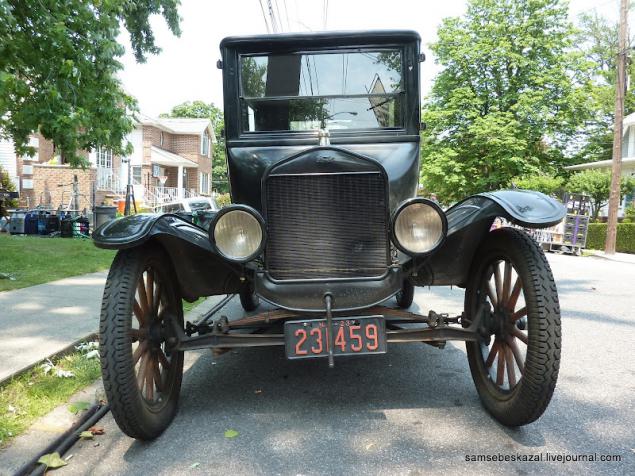
6. Windshield consisted of two horizontal parts. Janitor become standard equipment only later. Nickel-plated were very few details. On these machines, only the radiator cap rims on headlamps, door handles, caps on hubs, and some elements of the interior trim.
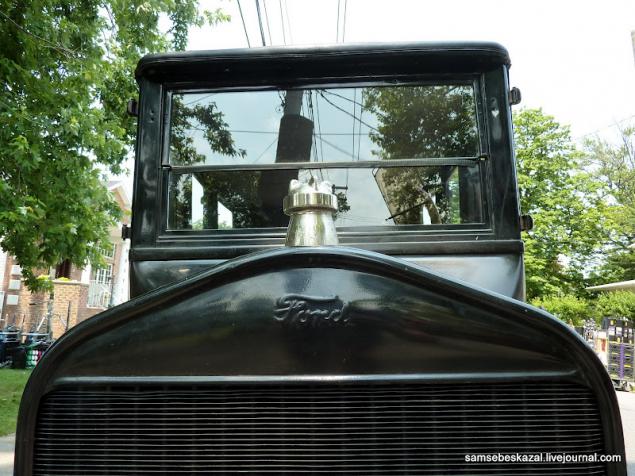
7. Handle the charging car was not much difficult operation, but he still needed a certain skill and experience. More than confident that none of today's drivers will not be able to do this without having studied the instructions above. Plant should have only the left hand. The frost, when the oil was thick, not completely disconnects the engine from the transmission, and the curve of the starter could bring down the owner down.
Process zavodki can look at this video from 8:36.

8. Buttons lock door opening time were common sliding bolts. But the side windows go up and down quite a familiar way for us.
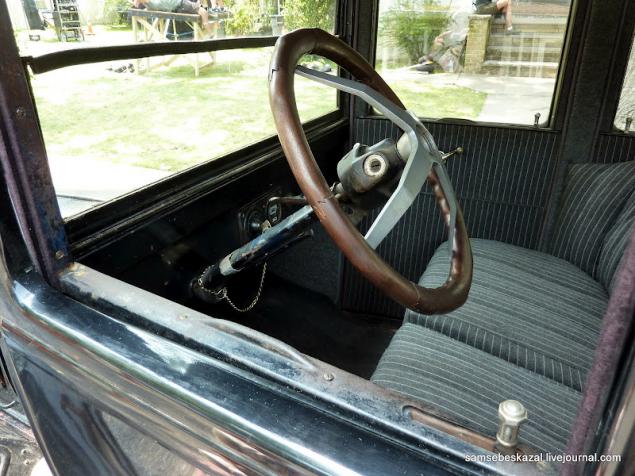
9. The opening mechanism of the upper half of the windshield. No sun visors in the cabin yet.
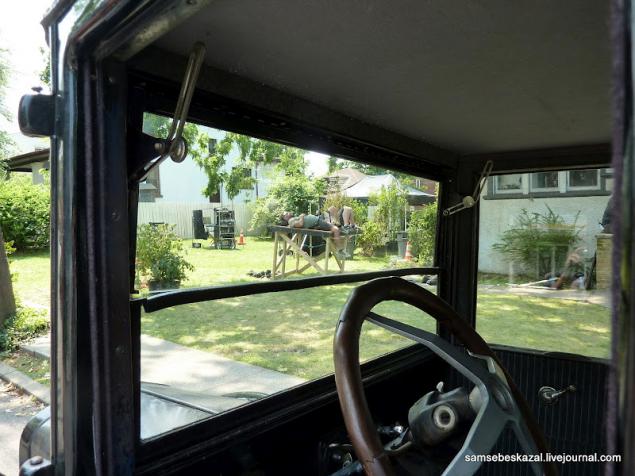
10. Roofs then put outside of the windshield. Under the rectangular cover, which is located on the hood in front of the windshield is not vent, as you might think, and the fuel tank filler neck with the cork. The fuel level in the tank is checked by a special ruler with divisions that had to be thrust straight into the gas tank. Himself tank was under the hood, where it was moved from under the driver's seat, where he settled in earlier versions. Gasoline gravity fed into the engine, and because of the location of the tank car glohla when climbing in steep mountain. Drivers had to turn around and climb back in. The oil level is checked also quite original way. No probes course not. We had to crawl under the car and found two plugs stacked on the engine. Unscrew the top and see if it potekshee of oil, it's okay. If there is no oil, unscrew the bottom, if not there, then it is necessary to refill. Top up until it flows over the edge of the filler neck.
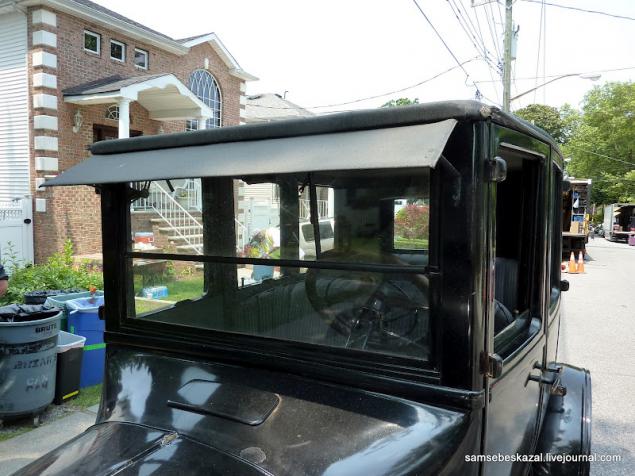
11. Door handles. No locking key was not. Loops at the door outside.
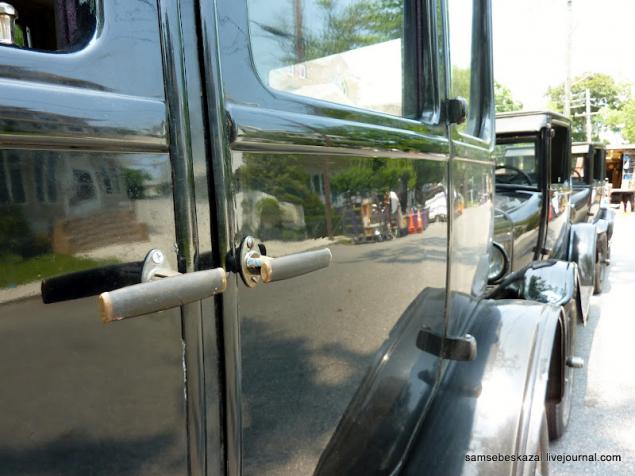
12. Body Fordor sedan - four-door saloon (sedan was still a two-door - Tudor sedan). In 1925, this machine cost $ 660, which is about 8 200 in today's dollars. Sedan was the most expensive car in the lineup.

13-T Ford coupe. In 1925, it cost $ 520, which is about 6500 dollars today. The average price of a house in 1925 was about $ 5000 - $ 8000 dollars ($ 62,000 - $ 100,000 today), depending on the size of saogo houses, land on which it stands, and its location.
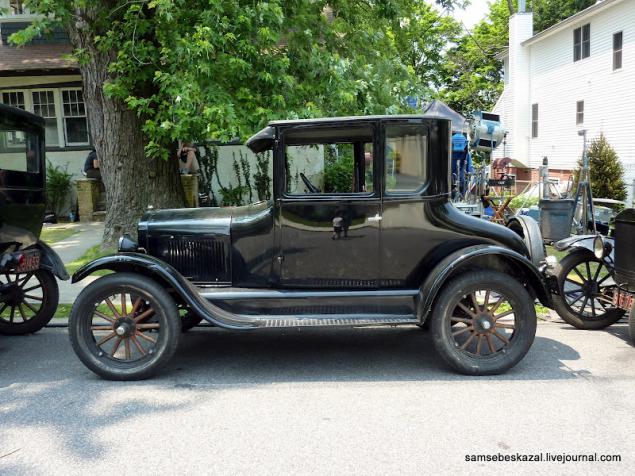
14. Another sedan. Engine Ford-T was a four-cylinder 2.9-liter capacity, with capacity of 20 hp The car developed a speed of 45 miles per hour. Average consumption was equal to one gallon per 25 miles (11 liters per 100 km.), But much depends on the quality of the road. Tank capacity is 10 gallons (about 38 liters).
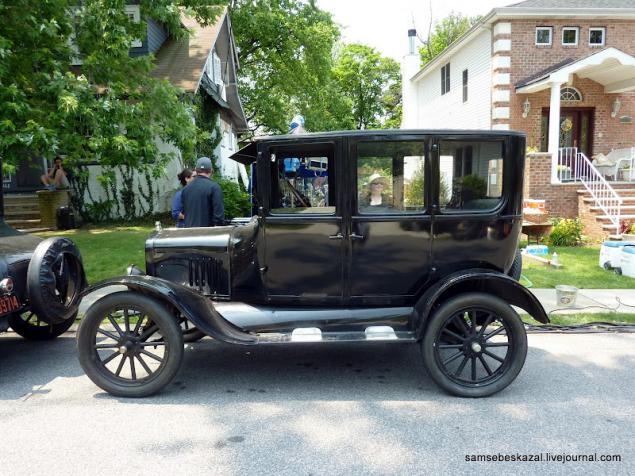
15. Behind the car is only one position lamp. Audio stop signal, turn signal or not.
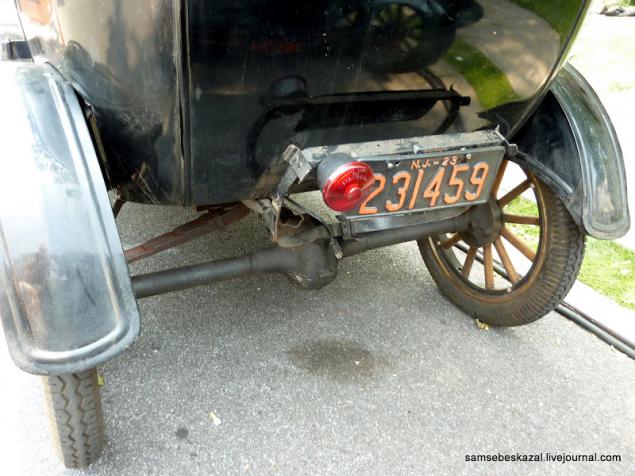
16. The open wiring to the headlamps. Sami magneto lights worked and the brightness dependent on the driving speed. And the speed depended on the quality of the road. It turned out that the worse was the way the dimmer lights shone.
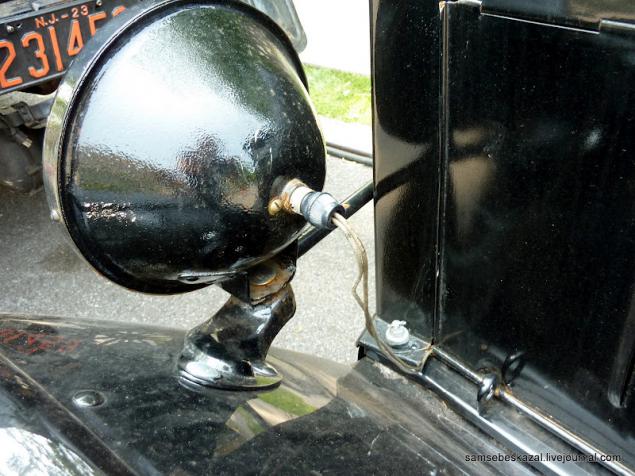
17. The rear-view mirror in the cabin. Some drivers in order to increase survey two mirrors installed nearby. Side mirrors were not.
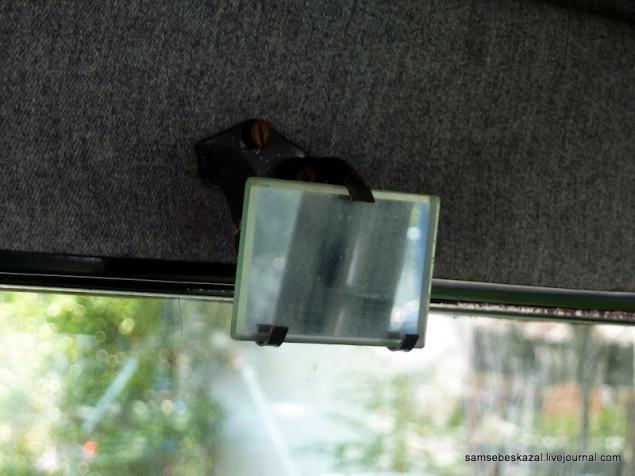
18. The inscription "Ford. Made in the USA "on the hub cap.

19. Special pads on the threshold of one of the sedans.
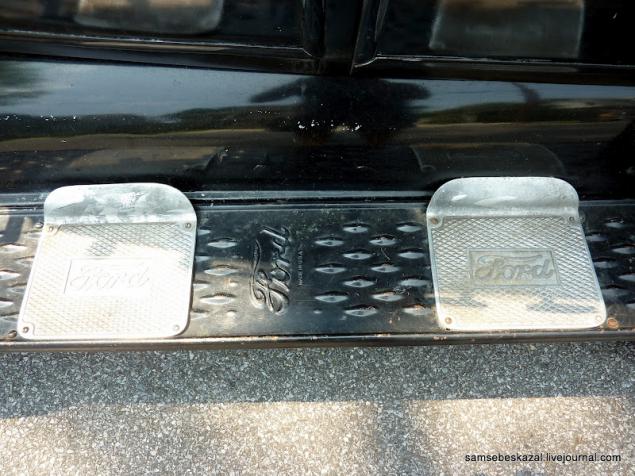
20. At the very threshold also proudly reported on the place of manufacture of the vehicle. Besides the US, Ford-T was collected in Argentina, Australia, Brazil, Canada, Denmark, Germany, the UK and Ireland.
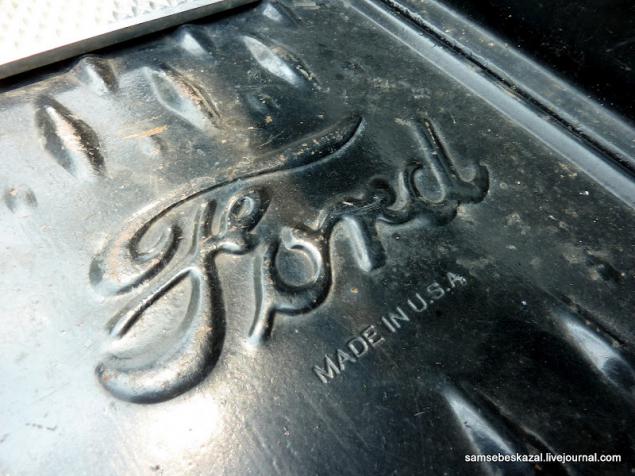
21. If you look under the car behind, you can see an interesting curve of the rear suspension, exhaust pipes and a modern battery.

22. In the Ford-T had wooden wheels with 12 spokes oval.

23. Spare wheel consists of a rim with tire and rims are attached to the four bolts.

24. Ford Coupe was the only one on set who had a trunk.

25. Sedan pretty cramped inside, especially in the front. But a full-fledged car with a roof and doors, not a wagon with an engine. This machine generally rich equipment. In addition to the mirror, there is a janitor and interior light.

26. This sedan interior steering cloth. Produced as sedans with leather seats and leatherette trim.
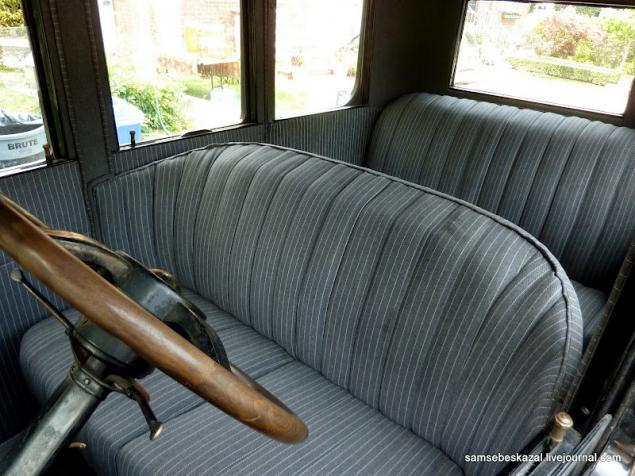
27. On the other side of the street were two cars with folding top. The street with a slight slope, and the wheels were turned by the rules towards the curb. The angle of rotation of the wheels can be the envy of any modern car. This is an early version with a short hood. The fuel tank is located under them the driver's seat. For the filling you need to lift the seat cushion.
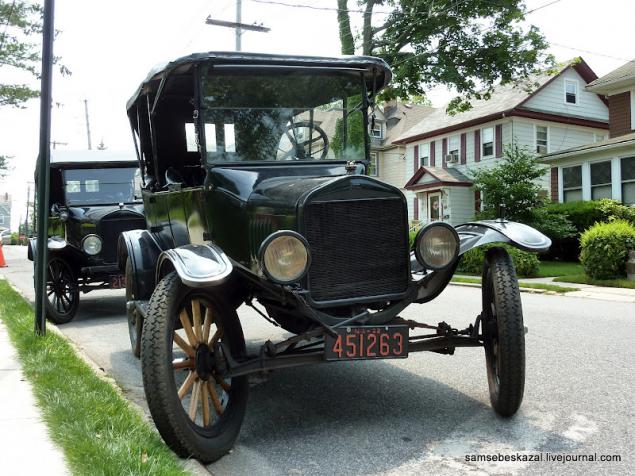
28. Ford T in the back of touring (touring) with folding top. This car cost $ 290 ($ 3,600 today) It was a little more than two months' salary normal working assembly line Ford at that time. The cheapest car in the full line of Ford-T was in the back of the roadster - a two-seater with a retractable roof. It cost $ 260 ($ 3,250 today). It was cheaper to just a single chassis-cabs, which cost just $ 225 ($ 2,800 today). Total Ford-T was performed in 9 and the various bodies, including freighters.
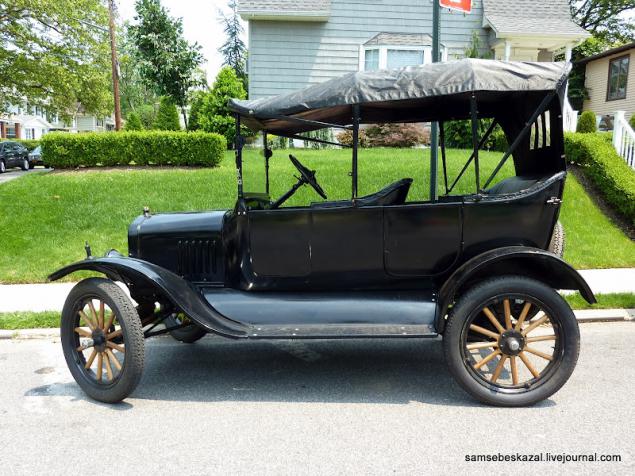
29. The fabric top was made of canvas painted in gray. On request it can be painted in a dark green or dark red color.
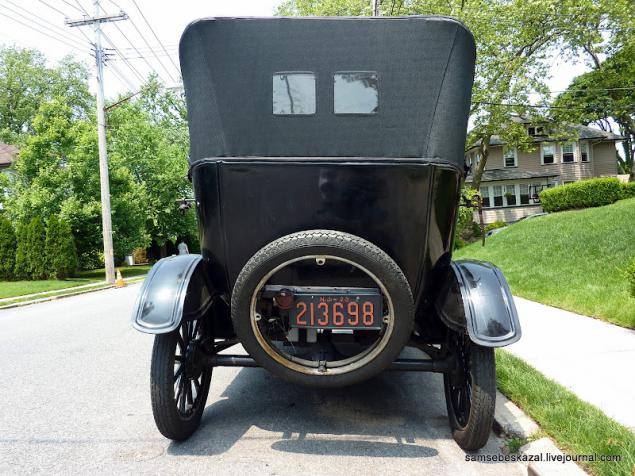
30. The leather case with strap for the "curve starter." Bumpers the car had no front or rear.
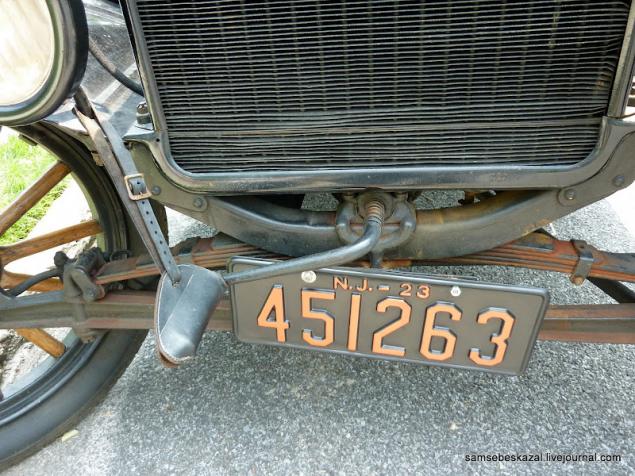
31. Due to the lack of glazing, it seems that the cabin touring roomier than the sedan.
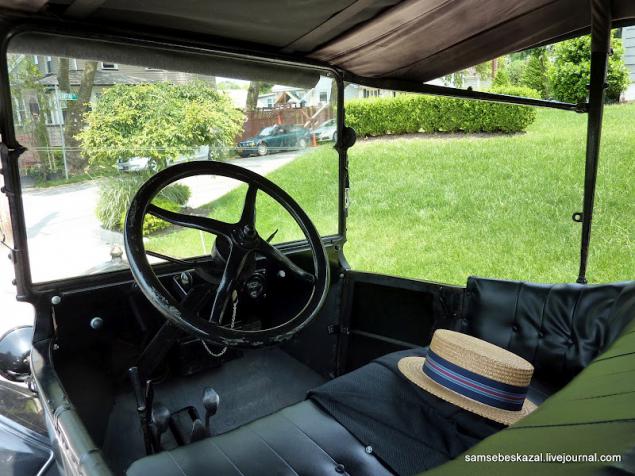
32. turn the key to the left turns on the ignition coil is powered by a rechargeable battery. Right - magneto. Start the car handle and wilderness already turning the key. For the extra money it was possible to establish an electric starter. To the right of the key ammeter.

33. Tire Firestone. The tires were cameras.

34. The dimension of the tire.

35. The tread pattern.
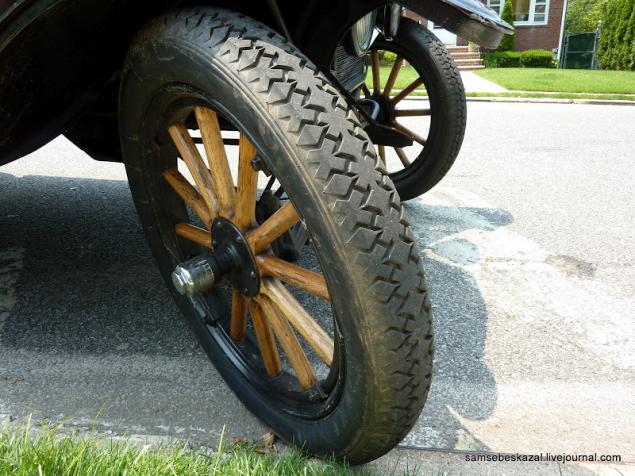
36. Machine with Australian tires.
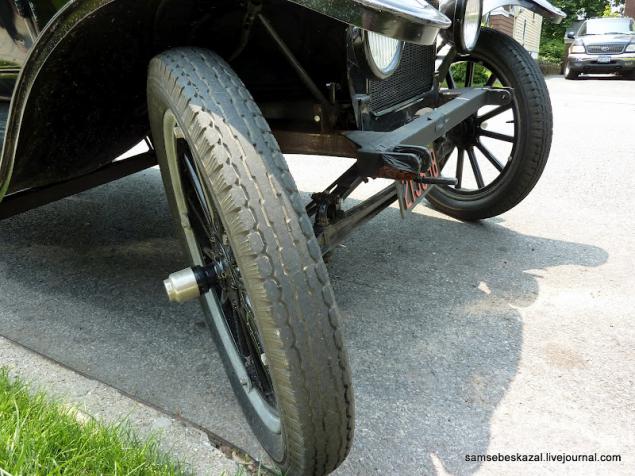
37. A set of tools for the repair of tires from the book for repair and maintenance.

38. Additional kerosene lantern.
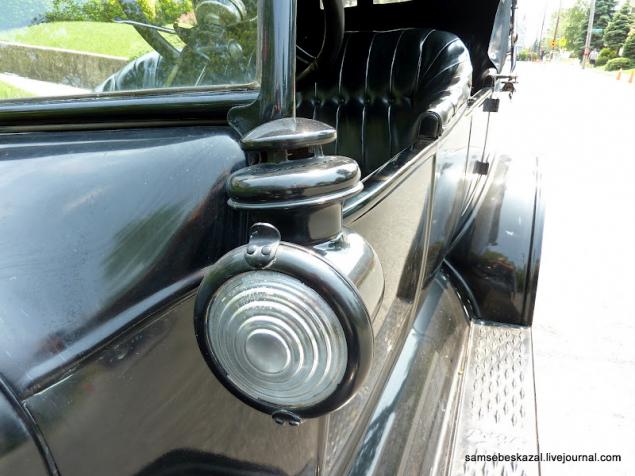
39. Pedal assembly seems familiar, but this is not the usual "clutch-brake-gas." The left pedal switches the whole two transmission (reduced - Neutral - high), includes a central back up, and the right pedal is the brake. Drum brakes were on the rear wheels only. Brake linings were made of bronze and quickly wore out. The box itself was a planetary gear type.
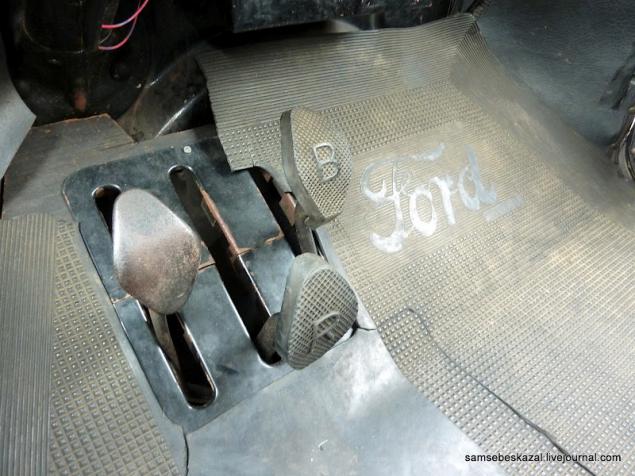
40. Habitual gas pedal there. Instead, the right lever under the steering wheel. Where in modern cars is the control unit wipers. Left lever ignition timing.
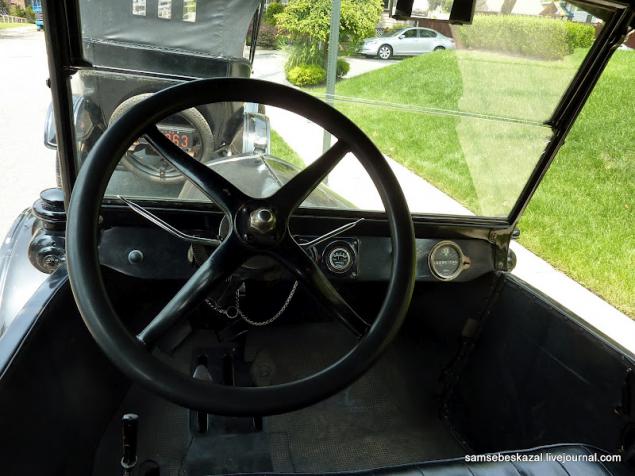
41. Scheme of the levers. They moved into a certain number of divisions. To move at maximum speed it was necessary to lower the two levers down.

42. The lever on the left is a manual transmission brake and gearshift in neutral position. The leftmost position (as pictured) - the machine is on the handbrake. If you move the lever to the center position (90 degrees to the floor), it will be neutral, push the pedal up and downshift. To switch, you must move the lever to the far right, the pedal will pop up in neutral, push it down, and you go on overdrive. For emergency stop at the same time it was necessary to press the pedal transmission, brake and pull the lever towards you until it stops. Braking was very difficult. The handle to the right of the instrument - air damper control.

43. A speedometer with odometer. The speedometer was standard equipment and produces several third-party vendors. It can be installed on the machine for an extra $ 65.

44. The mechanism of the speedometer located on the right front wheel and pinion was.
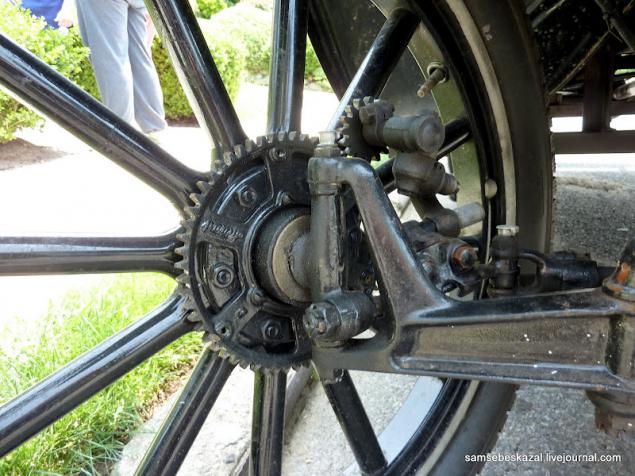
45. Modification without a speedometer. Of the five cars involved in the shooting of the speedometer was only one.

46. Upholstery open cars were of thick black genuine leather tanning special.
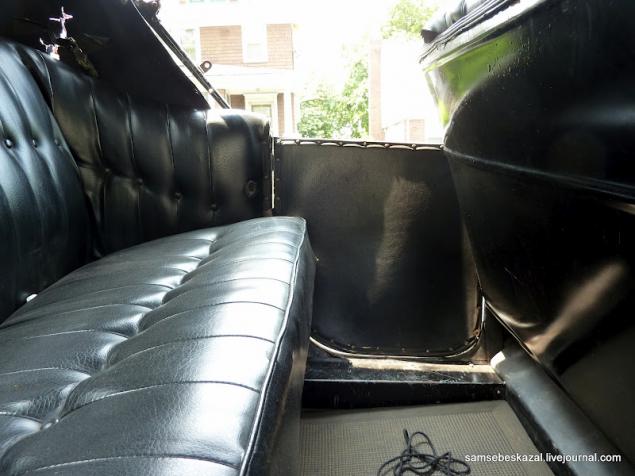
47. The silencer was propulsive and make a thin sheet steel with asbestos gaskets between the components.
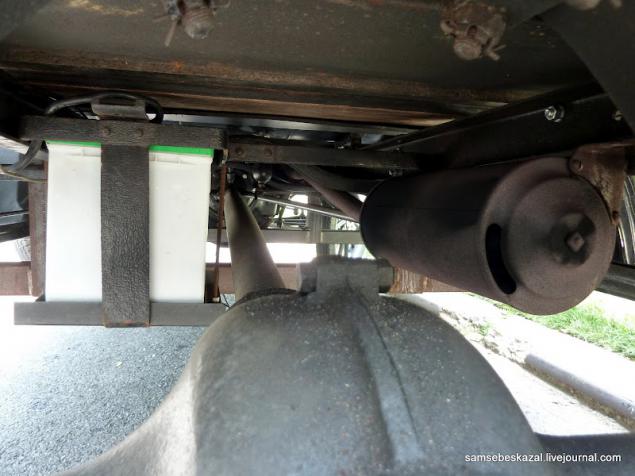
48. A total of 16.5 million vehicles sold to Ford-T. Despite the fact that since the end of the production has passed 85 years, only the Volkswagen Beetle was able to break this record.
Posted in [mergetime] 1339576904 [/ mergetime]
A short video of the machine from the set.
If interested, the original book on the repair and maintenance of the Ford-T 1917 can be downloaded in pdf.
All.
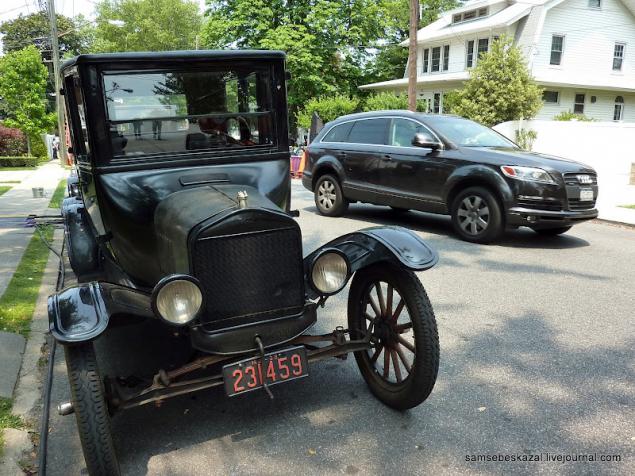
Source:
Yesterday's shooting day of the series Boardwalk Empire took place in the street, and were involved in the scene old cars. Today, not a word about the movie, but only about cars. Especially because I have long ago did not write about them.
1.

All the cars were the same model - it was the legendary Ford T in different versions. On the Internet, he found the name "Tin Lizzie", which is a direct translation of the American nickname «Tin Lizzy», which in my opinion is not very true, if you try to understand its origins. There are several versions of the origin of the name, and none of them confirmed. I was the closest one in which they say that Lizzie was the most common nickname workers horses on change which came inexpensive and reliable Ford-T. He was immediately christened the same name as that of a horse. Tin - Tin-plated iron is - tin, used to make cans. It would be correct to say "Tin Lizzie." Ford Model T cars were produced so much, and they were so long that later became known as the Tin Lizzy any old collapsing technique. We now call the old car-wreck "bucket", as the Americans called tin lizzy.
2.

Henry Ford himself called his Ford T "the universal car," the owners, in addition to Tin Lizzie nazyvalie simply Tee, rattletrap, clunker, wreck, bug-infested on gasoline go and many other equally colorful nicknames. But it's certainly love. Indeed, precisely because America Lizzie sat behind the wheel of the car and went.
3.

4. "The car can be any color, provided that the black" - once said Henry Ford. The reason was the assembly-line production and the fact that of all the enamels used for painting, most likely it dries black. For only 48 hours, while other colors could dry weeks. With the development of chemistry, this problem has disappeared, and Ford began to offer the body in other colors, but the wings and some elements still remained black due to the nature of the conveyor assembly.

5. The suspension consisted of two transverse springs. Because of this, the car pretty well swayed from side to side over the potholes and bumps. A road was then America consisted entirely of the most bumps and irregularities. Highway in the United States was not there, but the bad roads was rife. Due to the large ground clearance is perfectly overcome any off-road, and if they get stuck, then pull the car weighs just 850 kilograms on narrow tires are not a serious problem. Several adult men could easily pushed him even from the deepest mud.

6. Windshield consisted of two horizontal parts. Janitor become standard equipment only later. Nickel-plated were very few details. On these machines, only the radiator cap rims on headlamps, door handles, caps on hubs, and some elements of the interior trim.

7. Handle the charging car was not much difficult operation, but he still needed a certain skill and experience. More than confident that none of today's drivers will not be able to do this without having studied the instructions above. Plant should have only the left hand. The frost, when the oil was thick, not completely disconnects the engine from the transmission, and the curve of the starter could bring down the owner down.
Process zavodki can look at this video from 8:36.

8. Buttons lock door opening time were common sliding bolts. But the side windows go up and down quite a familiar way for us.

9. The opening mechanism of the upper half of the windshield. No sun visors in the cabin yet.

10. Roofs then put outside of the windshield. Under the rectangular cover, which is located on the hood in front of the windshield is not vent, as you might think, and the fuel tank filler neck with the cork. The fuel level in the tank is checked by a special ruler with divisions that had to be thrust straight into the gas tank. Himself tank was under the hood, where it was moved from under the driver's seat, where he settled in earlier versions. Gasoline gravity fed into the engine, and because of the location of the tank car glohla when climbing in steep mountain. Drivers had to turn around and climb back in. The oil level is checked also quite original way. No probes course not. We had to crawl under the car and found two plugs stacked on the engine. Unscrew the top and see if it potekshee of oil, it's okay. If there is no oil, unscrew the bottom, if not there, then it is necessary to refill. Top up until it flows over the edge of the filler neck.

11. Door handles. No locking key was not. Loops at the door outside.

12. Body Fordor sedan - four-door saloon (sedan was still a two-door - Tudor sedan). In 1925, this machine cost $ 660, which is about 8 200 in today's dollars. Sedan was the most expensive car in the lineup.

13-T Ford coupe. In 1925, it cost $ 520, which is about 6500 dollars today. The average price of a house in 1925 was about $ 5000 - $ 8000 dollars ($ 62,000 - $ 100,000 today), depending on the size of saogo houses, land on which it stands, and its location.

14. Another sedan. Engine Ford-T was a four-cylinder 2.9-liter capacity, with capacity of 20 hp The car developed a speed of 45 miles per hour. Average consumption was equal to one gallon per 25 miles (11 liters per 100 km.), But much depends on the quality of the road. Tank capacity is 10 gallons (about 38 liters).

15. Behind the car is only one position lamp. Audio stop signal, turn signal or not.

16. The open wiring to the headlamps. Sami magneto lights worked and the brightness dependent on the driving speed. And the speed depended on the quality of the road. It turned out that the worse was the way the dimmer lights shone.

17. The rear-view mirror in the cabin. Some drivers in order to increase survey two mirrors installed nearby. Side mirrors were not.

18. The inscription "Ford. Made in the USA "on the hub cap.

19. Special pads on the threshold of one of the sedans.

20. At the very threshold also proudly reported on the place of manufacture of the vehicle. Besides the US, Ford-T was collected in Argentina, Australia, Brazil, Canada, Denmark, Germany, the UK and Ireland.

21. If you look under the car behind, you can see an interesting curve of the rear suspension, exhaust pipes and a modern battery.

22. In the Ford-T had wooden wheels with 12 spokes oval.

23. Spare wheel consists of a rim with tire and rims are attached to the four bolts.

24. Ford Coupe was the only one on set who had a trunk.

25. Sedan pretty cramped inside, especially in the front. But a full-fledged car with a roof and doors, not a wagon with an engine. This machine generally rich equipment. In addition to the mirror, there is a janitor and interior light.

26. This sedan interior steering cloth. Produced as sedans with leather seats and leatherette trim.

27. On the other side of the street were two cars with folding top. The street with a slight slope, and the wheels were turned by the rules towards the curb. The angle of rotation of the wheels can be the envy of any modern car. This is an early version with a short hood. The fuel tank is located under them the driver's seat. For the filling you need to lift the seat cushion.

28. Ford T in the back of touring (touring) with folding top. This car cost $ 290 ($ 3,600 today) It was a little more than two months' salary normal working assembly line Ford at that time. The cheapest car in the full line of Ford-T was in the back of the roadster - a two-seater with a retractable roof. It cost $ 260 ($ 3,250 today). It was cheaper to just a single chassis-cabs, which cost just $ 225 ($ 2,800 today). Total Ford-T was performed in 9 and the various bodies, including freighters.

29. The fabric top was made of canvas painted in gray. On request it can be painted in a dark green or dark red color.

30. The leather case with strap for the "curve starter." Bumpers the car had no front or rear.

31. Due to the lack of glazing, it seems that the cabin touring roomier than the sedan.

32. turn the key to the left turns on the ignition coil is powered by a rechargeable battery. Right - magneto. Start the car handle and wilderness already turning the key. For the extra money it was possible to establish an electric starter. To the right of the key ammeter.

33. Tire Firestone. The tires were cameras.

34. The dimension of the tire.

35. The tread pattern.

36. Machine with Australian tires.

37. A set of tools for the repair of tires from the book for repair and maintenance.

38. Additional kerosene lantern.

39. Pedal assembly seems familiar, but this is not the usual "clutch-brake-gas." The left pedal switches the whole two transmission (reduced - Neutral - high), includes a central back up, and the right pedal is the brake. Drum brakes were on the rear wheels only. Brake linings were made of bronze and quickly wore out. The box itself was a planetary gear type.

40. Habitual gas pedal there. Instead, the right lever under the steering wheel. Where in modern cars is the control unit wipers. Left lever ignition timing.

41. Scheme of the levers. They moved into a certain number of divisions. To move at maximum speed it was necessary to lower the two levers down.

42. The lever on the left is a manual transmission brake and gearshift in neutral position. The leftmost position (as pictured) - the machine is on the handbrake. If you move the lever to the center position (90 degrees to the floor), it will be neutral, push the pedal up and downshift. To switch, you must move the lever to the far right, the pedal will pop up in neutral, push it down, and you go on overdrive. For emergency stop at the same time it was necessary to press the pedal transmission, brake and pull the lever towards you until it stops. Braking was very difficult. The handle to the right of the instrument - air damper control.

43. A speedometer with odometer. The speedometer was standard equipment and produces several third-party vendors. It can be installed on the machine for an extra $ 65.

44. The mechanism of the speedometer located on the right front wheel and pinion was.

45. Modification without a speedometer. Of the five cars involved in the shooting of the speedometer was only one.

46. Upholstery open cars were of thick black genuine leather tanning special.

47. The silencer was propulsive and make a thin sheet steel with asbestos gaskets between the components.

48. A total of 16.5 million vehicles sold to Ford-T. Despite the fact that since the end of the production has passed 85 years, only the Volkswagen Beetle was able to break this record.
Posted in [mergetime] 1339576904 [/ mergetime]
A short video of the machine from the set.
If interested, the original book on the repair and maintenance of the Ford-T 1917 can be downloaded in pdf.
All.

Source:









